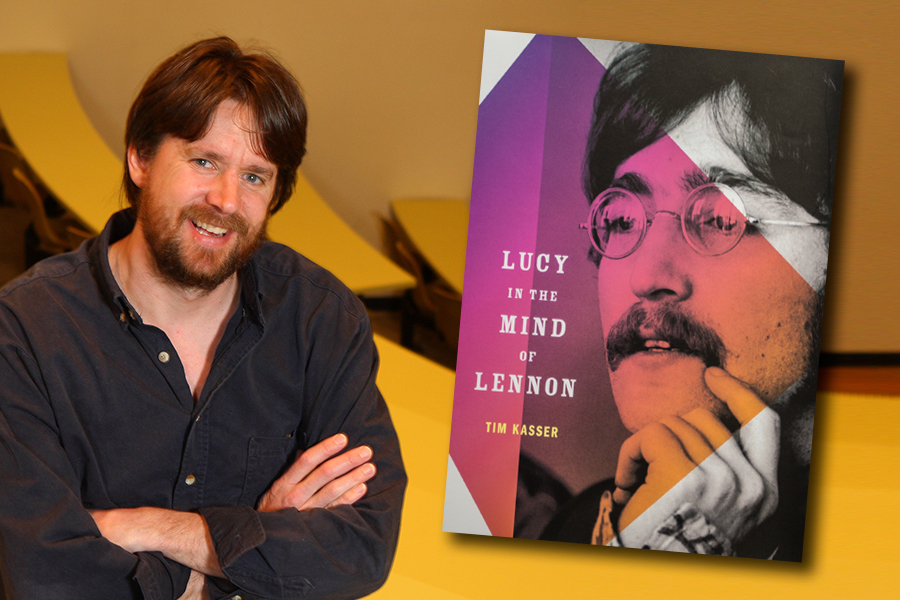

Exploring John Lennon's Lavish Dream
Knox Professor's Book: "Lucy in the Mind of Lennon"
Fifty years after the release of the Beatles' famous Sgt. Pepper's Lonely Hearts Club Band, now being reissued in several versions, one of the album's most famous tracks, "Lucy in the Sky with Diamonds," is getting attention with a newly released first take—and still generating discussion over its meaning. The song was described by Rolling Stone magazine as "Lennon's lavish dream." So who better to write about the meaning behind this Beatles song than a professor who has taught a class in which Lennon is one of the primary subjects, and has spent the last decade helping students understand their dreams.
In his 2013 book, Lucy in the Mind of Lennon (Oxford University Press), Professor of Psychology Tim Kasser applies innovative psychological methods to the song's lyrics and music. Combined with the facts of Lennon's life, Kasser offers a unique perspective on the psychology behind the song.
For a scholar whose primary area of academic concentration is materialism and consumer culture, a psychobiography about a musician and his song may seem like a sudden change in interest, but for Kasser, Lucy in the Mind of Lennon was a long time coming.
Why Lennon? Why "Lucy in the Sky with Diamonds?"
Lennon is someone I've been interested in since my college days. He was the first person I thought about trying to understand in my role as a psychologist.
I started writing about Lennon more than 15 years ago, but I ultimately came to this angle on Lennon mostly through happenstance. I was working on a very different book on Lennon at the time and was looking at the songs between Revolver and White Album, when Lennon used a lot of florid wordplay and the lyrics are pretty obscure. To help me make sense of those songs, I used a method called "scripting," which I teach about in my upper-level personality class. "Lucy in the Sky with Diamonds" just happened to be the song that was in front of me at the time, and when I scripted the song's lyrics to find the underlying plot, or theme, what I found led me to change the direction of what I was writing.
How would you describe Lucy in the Mind of Lennon?
I think of the book as being structured a bit like a mystery. The first chapter raises the question people have been asking for four decades—what is "Lucy in the Sky with Diamonds" about? In chapters two through five, I present different kinds of evidence I collected about the song. Chapters two, three, and four focus on the lyrics, while chapter five looks at the music. What I'm trying to do throughout is analyze the song, not based on my intuitions and hunches, but instead by adapting psychological methods that other researchers have used and applying them to "Lucy in the Sky with Diamonds." By the end of chapter five, hopefully, the reader has a sense of what the basic characteristics of the song are, or, to continue the metaphor, what the "crime scene" looks like.
Chapter six gives background on Lennon's life, breaking it down into his deep past, what had happened in the year before he wrote the song, and the "stimulus" that kicked off the creation of the song, which was that his almost four-year-old son, Julian, drew a picture that he said was of his friend Lucy up in the sky with diamonds. Finally, by chapter seven, I suggest a hypothesis as to what was going on for Lennon in the song.
What I do in chapters eight and nine is test this hypothesis by suggesting what should happen in the next songs Lennon wrote if the hypothesis is correct. I hope readers will agree that those later songs seem to confirm what I suggest was behind "Lucy in the Sky with Diamonds."
How has your experience with your students helped in writing this book?
The class that has been most critical in my thinking about this book has been "The Study of the Person," which I've been teaching here at Knox for quite a while. The subject of the class is how to study one person in depth using scientific approaches. During the first half of the class, we study a historical figure; in the second half, we hire a person in Galesburg to be our class subject, and then students do 10 hours of assessment, share their data, and write a paper about the person.
The last few times I've taught the class, we've studied Lennon during the first half, so I've had many students write papers about Lennon over the years and we've spent a lot of time talking about him. Between my "Dreaming" class and "The Study of the Person" class, my experiences and conversations with students have helped to clarify my thinking about a host of different issues that I had to deal with in the book, including how to make sense out of the seeming nonsense that people's minds can create.
Was writing the book what you had hoped it would be?
Writing about Lennon was an interesting challenge. I've published many research papers following the standard quantitative empirical approach, but I was ready to do something different. This book is unlike anything I've ever written before—it was a totally different kind of challenge for me, but it was a challenge that in many ways came out of my experience teaching at Knox.
—Professor of Psychology Tim Kasser has taught at Knox since 1995. His primary areas of scholarly interest are materialism and consumer culture. Other books authored or edited by Kasser include The High Price of Materialism, Psychology and Consumer Culture, and Meeting Environmental Challenges.
Media Coverage of Kasser & Lucy in the Mind of Lennon
- "Lennon's 'Lucy' Under the Microscope" The Chronicle of Higher Education
- "Tim Kasser, Lucy in the Mind of Lennon, Rediscovers the Thrill of Research Chicago Tribune
- "Lucy in the Mind of Lennon" Psychology Today
- "Seven Things You Didn't Know About 'Lucy in the Sky with Diamonds'" Oxford University Press
Published on May 25, 2017

